Table of Contents
Toggle7 Proven Digital Marketing Strategies For Co-working Spaces [Case Study]

Want to market and monetize your co-working spaces?
If so, you’re at the right place.
In this guide, I’ll share 7 proven digital marketing strategies for co-working spaces that we use to fill co-working spaces for our clients.
Most of all, you’ll get the exact process that we used to reach 0-500 seats in record time for one of our clients.
Let’s jump right into the tactics.
1. Local SEO for co-working spaces
SEO is huge when it comes to earning high-quality traffic that has a solid buying intent.
In fact, 48% of online shoppers prefer using Google to get product or service recommendations on what to buy, according to thinkwithGoogle.
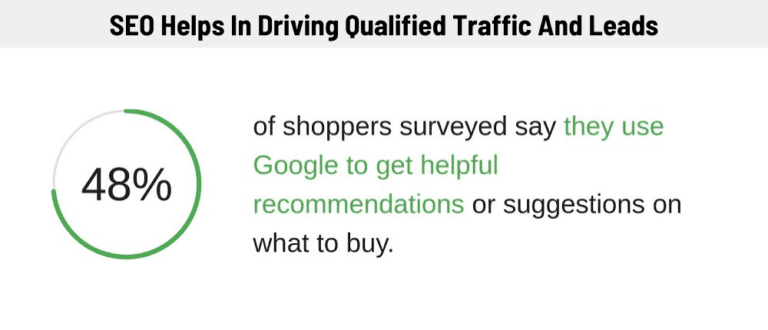
Here’s how you can build an SEO strategy to maximum exposure.
Start with local SEO
The first step in local SEO is setting up your Google My Business profile correctly.
While hiring co-working spaces, people generally avoid generic search terms such as “co-working spaces,” “top co-working spaces,” etc.
Instead, they look for location-specific solutions.
Some examples of search terms are:
- “co-working spaces in Gurgaon”
- “co-working space in Gurgaon golf course road”
So, how do you show up on Google when someone is looking for a co-working solution in your region?
This is where the GMB profile works amazingly.
Let me show you the SERP results for these kinds of geo-specific keywords:
Here are some of the important steps to optimize the profile:
- Create and verify GMB business profile
- Select relevant business categories (max of 10 categories are allowed). Add the most important search phrases.
- Upload high-quality images and videos of your co-working spaces.
- Acquiring and responding to customer reviews is super important.
- Publish and schedule offers, updates, and micro-content consistently to drive impressions.
- Lastly, keep tracking the performance metrics (impressions, clicks, sources, etc.)
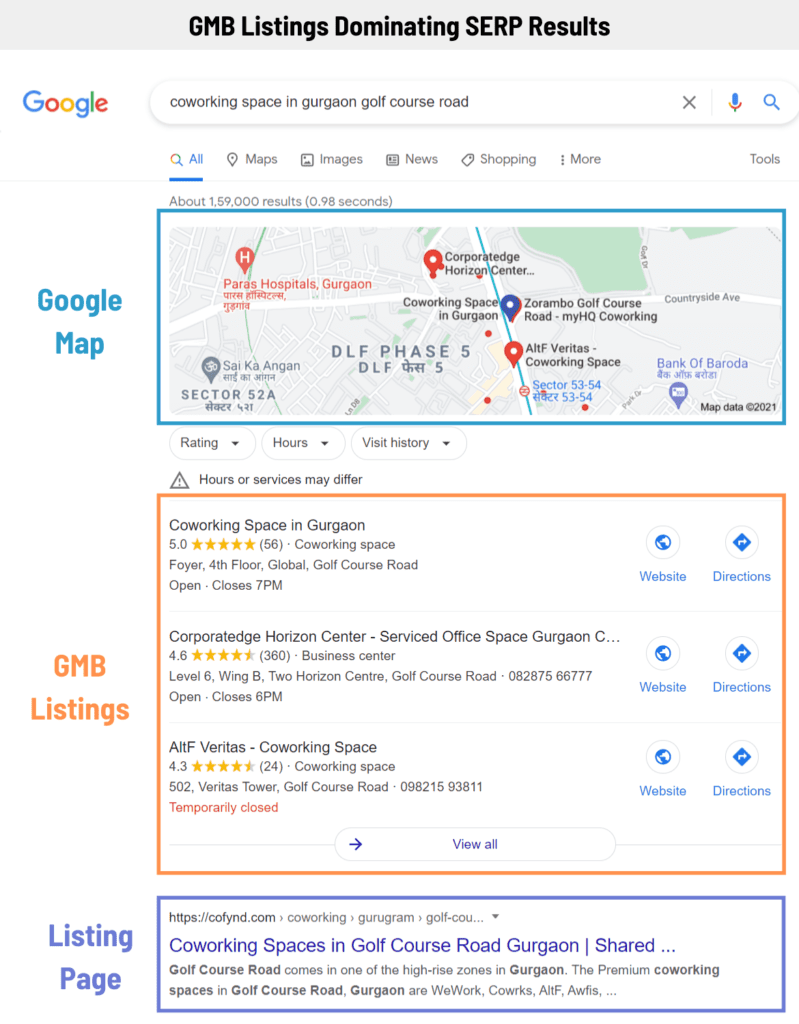
Local Citations
Local citations and links from local sites help you build authority in local SEO.
In case you’re unfamiliar, local citation refers to the mention of your business from third-party sites (competitors. Directories, etc.)
Here’s a tip on finding citation opportunities
Use the following search operators to find citation opportunities.
→ “co-working space” -site:Yourdomain.com + Gurgaon

2. LinkedIn outreaching
LinkedIn is a great place to find your ideal customer and build a connection with them.
But before diving into LinkedIn outreaching, you need to have a clear image of your target audience.
Here are some examples:
- Which location do you want to target?
- What type of audience are you targeting? Are they business owners, marketers, teachers, etc.?
- Type of business
- Service categories
- Industries, etc.
Once you’ve enough information about your customer profile, go to the next step to perform an advanced search on LinkedIn.
First, type the designation of your audience (for example, StartUp founders).
Next, select the locations, business categories, industries, language preferences to get a more relevant and narrowed list of prospects.
Here’s what you’ll get finally:

Now, it’s time to do cold outreaching. While doing cold outreach, it’s better to lower your ask in the beginning.
That means instead of pitching your services in the first message, ask for:
- 15 minutes meeting
- The approval to send them a live review of the co-working spaces, etc.
Important tip: Make your message as personalized as possible.
From looking at their LinkedIn profile, you can understand what type of business they’re running, where they are from, etc.
This will help your message stand out from others.
Note: with tools like Hunter, Getprospects; you can get email addresses from LinkedIn search and do cold outreach.
3. Google Advertising
Google ads is one of the fastest ways of reaching your target audience. With the location targeting feature in Google Ads, you can show your ads to specific locations.
For example, if you’re running a co-working space in Hyderabad, your ads will be shown to people in Hyderabad. Even better, you can also narrow down the location of targeting.

Here’s how to plan your Google Ads strategy for co-working space:
Start with identifying the objectives of your Ad campaign. Having a clear understanding of what’s your goal will help you in:
Choosing the right keywords
Optimizing your budget, and many more.
Set up local Ad extension
Especially for local businesses like co-working spaces, local Ads are very powerful.
Ad extensions provide extra features to your local ads. For example, a location extension will help users to understand where the co-working space is located.
Below is an example of location extension.

Other types of extension you can use are:
- Message extension
- Call extension
- Sitelink extension, etc.
Make sure that you already have a GMB account to use the extension feature.
Google ads budget breakdown
Generally, the budget breakdown depends on various factors such as a city (or any specific location), keywords, campaign adjectives, and many.
But here’s one of the Ad budget breakdowns that helped our clients in their co-working space business:
Budget Allocation | Ad campaign |
70% | Search campaigns |
20% | Display and video campaigns |
10% | Remarketing campaigns |
Let’s understand the above type of campaigns one by one.
1. Search campaigns:
Create a list of long-tail and short-tail keywords. You can use the free tool Google keyword planner to find keywords used by your audience.

Also, avoid broad keywords and ensure that the title and copy of the page match the search intent for a better quality score.
2. Display and video campaigns:
Video ads are a great way to showcase the features and interior of the co-working space. When it comes to video or display ads, make them actionable. For lead generation, ask the viewers to sign up for the form or call the business.

3. Remarketing campaigns:
Remarketing ads are helpful when you’ve already engaged the users via your website or mobile app. By targeting the people who interacted with your brand already makes a huge impact on the conversion.
Using testimonials and explainer videos in the remarketing campaign is a good practice to follow.
Note to remember: The budget for marketing campaigns depend on many factors such as city, competition and difficulty of market as every location has their own challenges.
4. Running Facebook & Instagram ads
Facebook ads allow you to narrow down your targeting based on location, interest, or even online activity.
The first and foremost thing you need to do is setting up the remarketing campaign.
If you’ve set up the pixel on your site, then you can show ads to people who’ve already interacted with your site or products pages.

One thing that worked well for us is to use testimonials/ customer reviews in Facebook retargeting ads.
You can use the reviews on your ad copy, facebook creatives, and even on title.
Other than Ad strategy, focus on the Ad copy, headline, call to action, and right targeting.
Select the right demographic details depending on who you want to target for your space.
Also, you don’t want to show your ads to people who are not aware of co-working space.
Therefore narrow down your audience list by interests such as shared space, co-working space, office space, etc.
To setup your Facebook or Instagram ads, you can select the following audience:
- Freelancers
- Startup Owners
- Business Page Admins
- People those have just registered their businesses
- Women entrepreneurs
Organic promotion on Instagram
Leverage Instagram’s organic reach, which is much higher as compared to Facebook.
Here are some of the content types you can publish on Instagram:
- Interior videos of co-working spaces
- Customer testimonials
- Upcoming events updates
- Informational carousel on importance of co-working space
Here’s an example from CoHive Coworking Office Space:

Also, especially on Instagram, maintaining your feed is as important as the content itself.
Because when someone visits your Instagram profile, your content feed will provide either great or poor experience to the users.
For example, let’s connect India (a co-working space) has done a good job in maintaining the brand message.
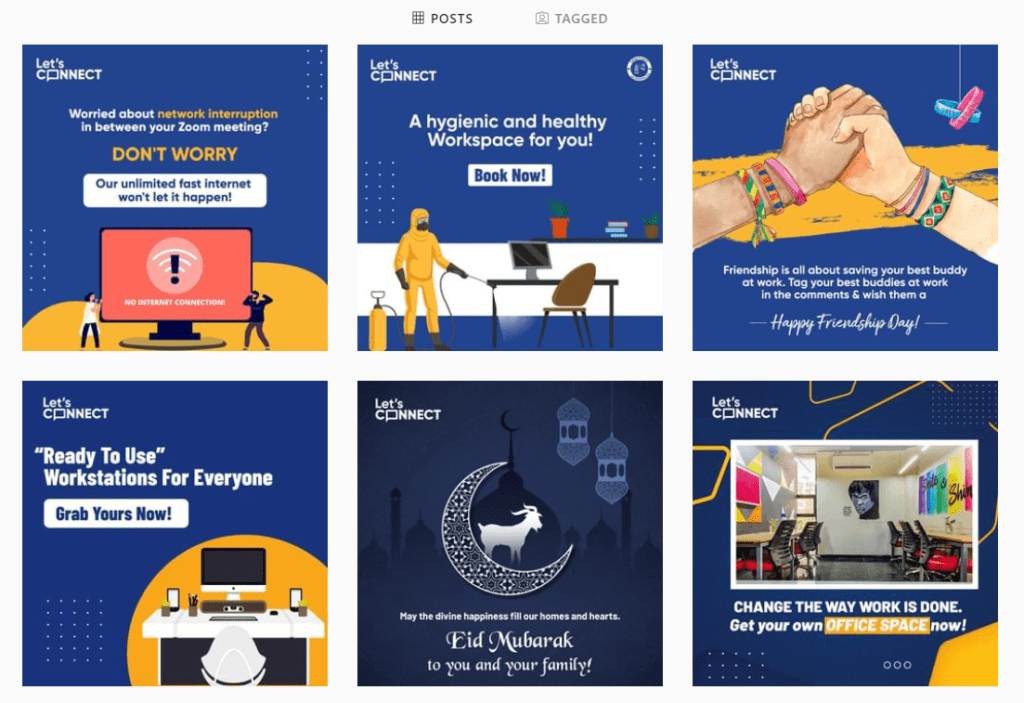
5. Conference Events for Co-working Space
Online marketing has a huge potential in reaching your target audience and generating leads for co-working spaces.
But offline events like conferences or meetings can boost your marketing efforts significantly.
Here are some of the ideas to conduct conference events successfully:
- Run workshops and events: Whether free or paid, you can generate a lot of hype in your local community with the right promotion.
Also, consider inviting influencers or experts to run a valuable educational workshop.
For example, we did conference events at Mumbai 91 that led to many business queries regarding co-woking spaces.
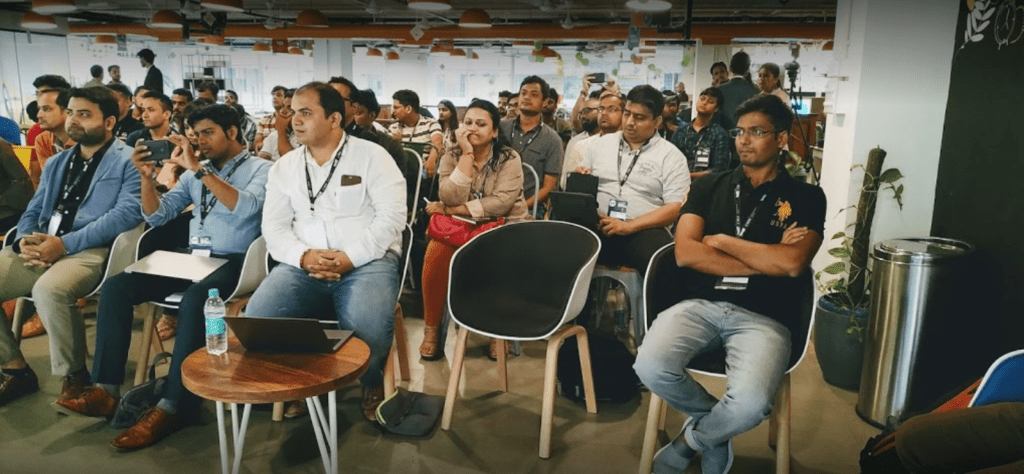
Here is another one image from digital marketing consultant meet in Kolkata:
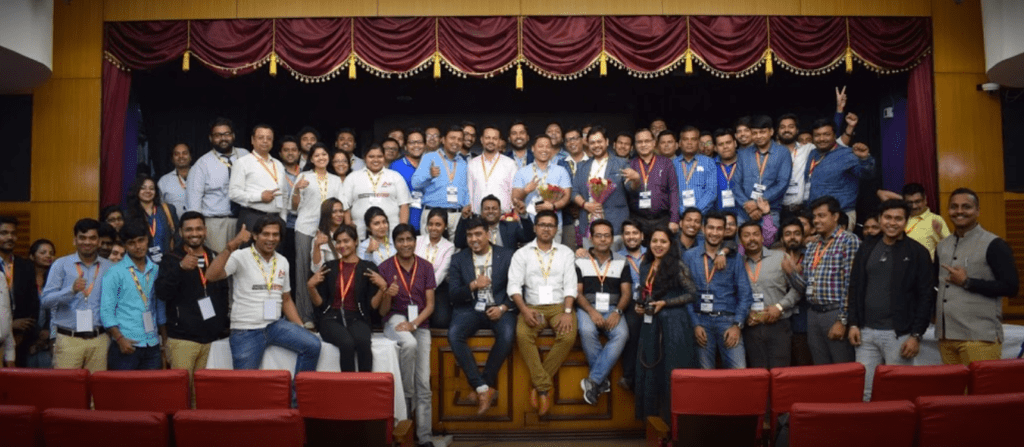
In short: Live events and workshops work well not only to drive engagement but also to promote your co-woking space.
- Non-profit or charity events: organizing non-profit events has many benefits, such as attracting local companies, creating buzz around your co-working space.
- Organize local TEDx talk (if relevant to your offerings): Surely, TEDx talk will give you huge exposure to your brand and co-working space. This is a great way to get your seats filled as the event is popular and valuable globally.
- Get members from platforms MeetUps or Eventbrite: You don’t always need to go out and find the members for upcoming events. Platforms like MeetUps will do that on your behalf. From creating a group to organizing the attendee lists, all is done by their officials. As a result, you can focus more on providing a rich experience in your co-working space.
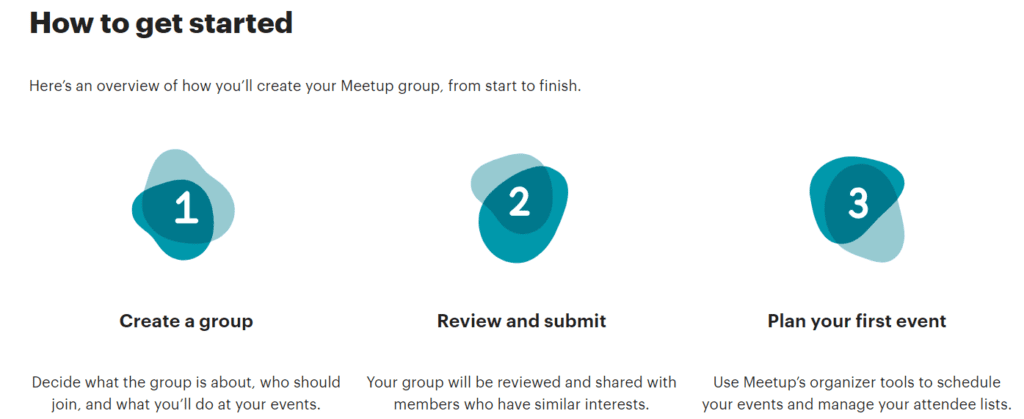
- Partner with local businesses: Referral or word-of-mouth is the
Digital Marketing Strategies For Co-working space. One of the ways to do that is by collaborating with local businesses. For example, you can collaborate with restaurants, hotels to offer special discounts only for your co-working members.
Here’s an image from one of the conference events that we organized to promote a co-working space.

6. Video marketing
Video is one of the most powerful mediums to form a connection with users. But how to create a video marketing strategy for a co-working space that builds awareness and leads to conversion?
While building a video marketing strategy, you need to consider three stages of the buyer’s journey such as:
- Awareness
- Consideration
- Decision
Let’s now discuss different types of videos you can create to cover each stage.

- Awareness stage: The goal is to drive engagement towards your brand, product, or service. Social media videos work best when it comes to awareness.
Where to publish: Try Facebook, Instagram, LinkedIn, etc.
- Consideration stage: This is the stage where you should be creating educational or explainer videos. For example, you can create videos on the features and available locations for co-working spaces in your region.
Where to publish: YouTube, Videos embedded into blog articles, etc.
- Decision: In this stage, users are already aware of your brand. So, your goal should be to build trust or tell a story.
Video testimonials are one way of building trust. You can also run Paid YouTube Ads for testimonials retargeting to those who’ve already visited the site or app.
Where to publish: About-us page, service page, YouTube, etc.
7. Optimizing CTAs and website for conversion [will include examples]
What’s the first thing possible customers want to do when they visit your website?
It’s finding the availability of co-working space in their preferred location.
So optimizing the above-the-fold section of your home page will offer a quality user experience.
Here’s an example from WeWork:

But that’s enough to convince visitors that your co-working space is the right solution for them.
Here are some of the must-have elements of your landing page:
- Simple, short, and clear heading
- Social proof (Add brand logos, customer images, etc.)

Example from innov8
- Featured videos (videos showcasing the beauty and features of your co-working spaces helps users to visualize the experience)
- Stats or quantified reviews
Below is an example that adds credibility to the co-working company:
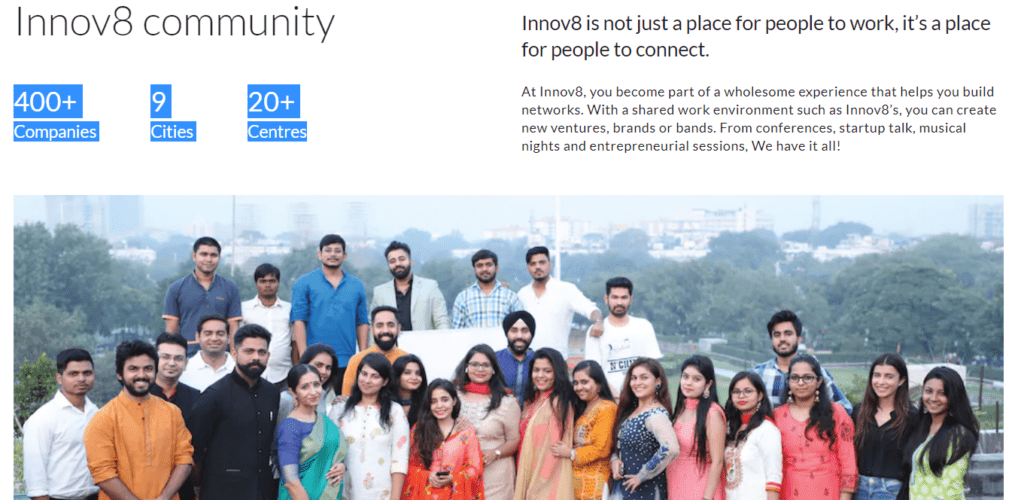
Clear CTAs (depends on your goals like lead generation, request a call, schedule demo, etc.)
The anatomy of a B2B service page
Though there is no fixed rule in designing the B2B service page for co-working spaces, the following framework can be considered a guideline.
OrbitMedia shared this B2B landing page framework that you can also model and use on your website.

8. Content strategy for co-working spaces
Content is like an investment that gives you a compound effect. But only when done with the right strategy.
Sharing content strategy framework for co-working businesses to reach more people, get leads, and build trust.
But before that, understand the basics of the marketing funnel. Three stages are:
- TOFU (top-of-the-funnel: When the audience isn’t aware of the service you’re offering. A good practice in this stage is to promote and build awareness of your brand)
- MOFU (Middle-of-the-funnel: People know your brand but are unsure whether you’re the right solution for them. Goal is to showcase your co-working space’s benefits, importance, etc.)
- BOFU (Bottom-of-the-funnel: Now, they’re ready to do the transaction but do they trust your company? Building trust and getting sales is the ultimate goal here)
Here are some of the content ideas you need to create:
Stage | Goal | Content types |
TOFU | Awareness, discoverability, etc. | Beginner’s content guide around co-working spaces. E.g → > “How does a co-working space work?” > “What do you need in a co-working space?” |
MOFU | Educating prospects | Educate the importance of co-working spaces, successful brand stories, etc. E.g → > “Are co-working spaces worth it?” |
BOFU | Leads, sales, & build trust | Help the users to take the final decision on the right co-working space solution for their needs. E.g → > “Customer case studies using your co-working spaces.” > “How much does WeWork space cost?” |
Now, let’s jump into the case study that helped us go from 0 to 500 seats for a co-working space.
9. How we helped a co-working space to get 500+ seats booked [Case study]
Here’s a step-by-step process that you can steal to market your coworking space:
Step 1. Keyword research
The campaign started with in-depth keyword research. The goal was to identify long-tail geo-specific keywords that have low competition but medium to high search volumes.
Some of these keywords are:
- “Co-working space in Delhi”
- “Cheap co-working space”
Tip: geo-specific and budget-based keywords have high business value for the company. So, it’s okay even if the search volume for these keywords is as low as 50/month.
Step 2. Local SEO
Local SEO is one of the biggest pillars of marketing success for us. We optimized the GMB profile and added lots of relevant pictures, videos of the workplace that attract a good number of impressions/month.
Also, GMB reviews are super important if you want to rank on local keywords and get leads.
Here’s the breakdown of local SEO ranking factors from Moz:

By focusing on customer reviews, we were able to collect 150+ genuine customer reviews.
Step 3. Conversion optimized website
To maximize the conversion, we optimized important pages such as the home page, about page, service sections, etc.
One element that worked well in this process is by adding lots of visuals of the co-working spaces.
Step 4. Video marketing
We found that people are more likely to book spaces when they can see a live demo or visualize the places. So, we decided to double down our efforts on video content.
Along with creating professional video content, we also collaborated with YouTubers to showcase our co-working spaces on their channel.
Here’s an video example that we shoot for our clients by collaborating with local YouTube channels:
Step 5. Paid ads
Considering the budget, resources, and marketing goals, we allocated 60% on Google Ads and 40% on Social media marketing and Youtube Ads.
Here’s the full breakdown for Google Ads:

Step 6. Hosting conference events
Events helped us to boost our overall marketing performance. We started organizing regular conference events, and as a result, many new inquiries came. Also, it motivated other local startups to organize such events in co-working spaces.
Here’s an image from the event:
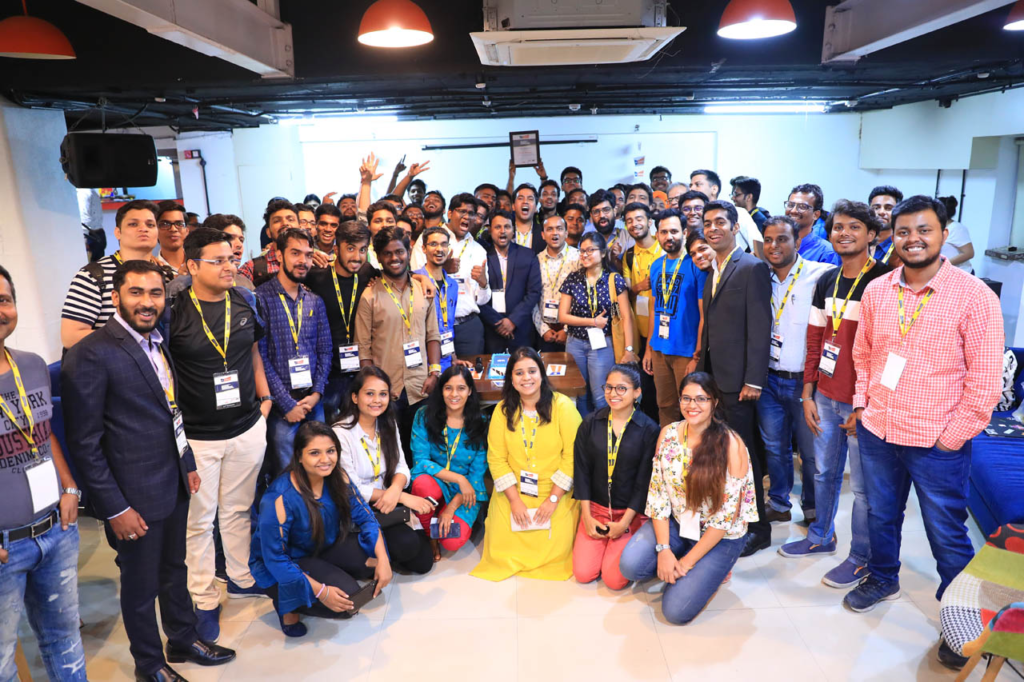
Final words
Creating a digital marketing strategy for co-working spaces requires a lot of planning and execution. Thanks to our marketing experts, we were able to generate good results for our clients. I hope these tips and strategies discussed in this guide will help you market your co-working spaces. Otherwise, contact our marketing experts and learn how to grow your business with digital marketing.
